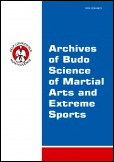2023, Volume 19, Issue 1
Factors affecting bone mineral density in young athletes of different disciplines: a cross-sectional study
Anna Kopiczko1
1Faculty of Physical Education, Józef Piłsudski University of Physical Education in Warsaw, Poland, Warsaw, Poland
Author for correspondence: Anna Kopiczko; Faculty of Physical Education, Józef Piłsudski University of Physical Education in Warsaw, Poland, Warsaw, Poland; email: anna.kopiczko@awf.edu.pl
Full text
Abstract
Background & Study Aim: Recent studies of bone mineral status have indicated that exercise increases and maintains bone mass and strength at various skeletal locations. In addition, it has been pointed out that intense exercise during growth and young adulthood may reduce the risk of fractures later in life. However, there is no clear consensus on the identification of the best exercise for the bones and a specific frequency of exercise. This study aimed was the knowledge about femoral neck (FN) and lumbar spine (L1-L4) bone mineral density (BMD) and bone mineral content (BMC) in adolescent athletes performing different disciplines.
Material & Methods: Data come from cross-sectional surveys with 156 boys from three physical activity (PA) groups: PA with a large OI (n = 54, speed-power athletes, throwing athletes, martial arts), PA with a low OI (n = 52, swimming, water polo, and diving) and inactive (n = 50). BMD and BMC were measured by densitometry. Body composition (fat mass- FM and fat free mass- FFM) was analysed using bioelectrical impedance methods. Eating habits were assessed using standardized dietary assessment questionnaires.
Results: The higher hip BMD was shown in boys from the PA with large OI. In the spine, boys in the group with a high proportion of exercise with large OI had the highest BMC. The strongest relationships with bone indicators were found for PA level, protein intake and dairy products. The main indicators significantly affecting BMD in the FN were: fat free mass (FFM), dairy products, calcium intake, protein intake and PA level (adj. R2 = 0.78). Significantly affecting BMD L1-L4 were: dairy products, protein intake, and PA level (adj.R2 = 0.63). In FN BMC the significantly affecting were: FFM, dairy products, protein intake and PA level (adj.R2 = 0.71). Similar results were obtained for total hip BMC, but in addition to the effect of dairy products. In BMC L1-L4 was significantly affected only PA level (adj.R2 = 0.31).
Conclusions: PA with a large OI proved to be a strong factor in determining the highest BMD in the hip and spine. This study also confirmed a significant effect on BMD by diet.
Key words: bone health in adolescence, calcium intake, dairy products, martial arts, protein intake, somatic features, speed-power athletes, throwing athletes





